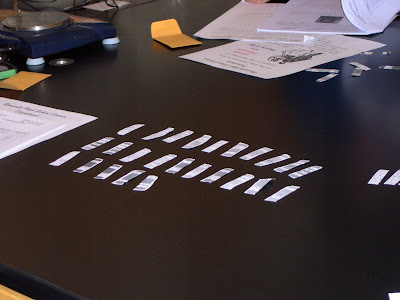CHROMOSOME PAIR
|
CHARACTERISTIC
|
1
|
Tongue Rolling
|
1
|
Face Shape
|
1
|
Skin Pigmentation
|
2
|
Mid Digital Hair
|
2
|
Chin Type
|
2
|
Skin Pigmentation
|
3
|
Chin Shape
|
3
|
Hair Color
|
4
|
Skin Pigmentation
|
4
|
Red Hair Color
|
5
|
Hair Color
|
5
|
Cleft Chin
|
6
|
Bent Little Finger
|
7
|
Hair Texture
|
8
|
Hair Line
|
9
|
Eyebrow Thickness
|
9
|
Forehead Freckles
|
10
|
Hair Color
|
10
|
Eyebrow Placement
|
11
|
Eye Color
|
11
|
Eye Placement
|
12
|
Eye Color
|
12
|
Eye Size
|
13
|
Eye Shape
|
14
|
Nose Shape
|
15
|
Eye Lash Size
|
16
|
Dimples
|
17
|
Mouth Width
|
18
|
Hair Color
|
18
|
Lip Thickness
|
19
|
Nose Size
|
20
|
PTC Tasting
|
21
|
Cheek Freckles
|
22
|
Ear Lobe
|
Sex Pair (Y chromosome)
|
Hairy Pinna
|
Sex Pair (X chromosome)
|
Red Green Colorblindness
|
This exercise allows the student to examine the following genetic concepts:
dominant and recessive
alleles;
sex linkage;
gene linkage;
independent assortment of alleles
as it occurs during meiosis and gametogenesis;
polygenic inheritance;
how one gene can influence the affect
of another gene (epistasis);
genotype and phenotype;
recognize that this variation of genes results
in the production of offspring with unique phenotypes.
The students achieve this by putting their alleles on paper representations of their chromosomes. Each half of the chromosome representation is one member of a homologous pair. When the chromosome is folded and dropped only one allele found on one member the pair is passed to the child via the gamete.
By combining their chromosomes with the chromosomes of a classmate the new individual that would be formed receives the two alleles need to express a trait. By completing this exercise twice the students see how their traits might combine in the production of an offspring. As the students complete this exercise they should come to appreciate the richness of variation that occurs as a result of the recombination of alleles during fertilization.
 |
| Student chromosomes |
 |
| Samantha and Erica are preparing to rejoin their homologous chromosomes. |
 |
| Cyrus and Malika are lining u heir homologous pairs. |
 |
| Andrew and Argentina are lining up their chromosomes. |



No comments:
Post a Comment